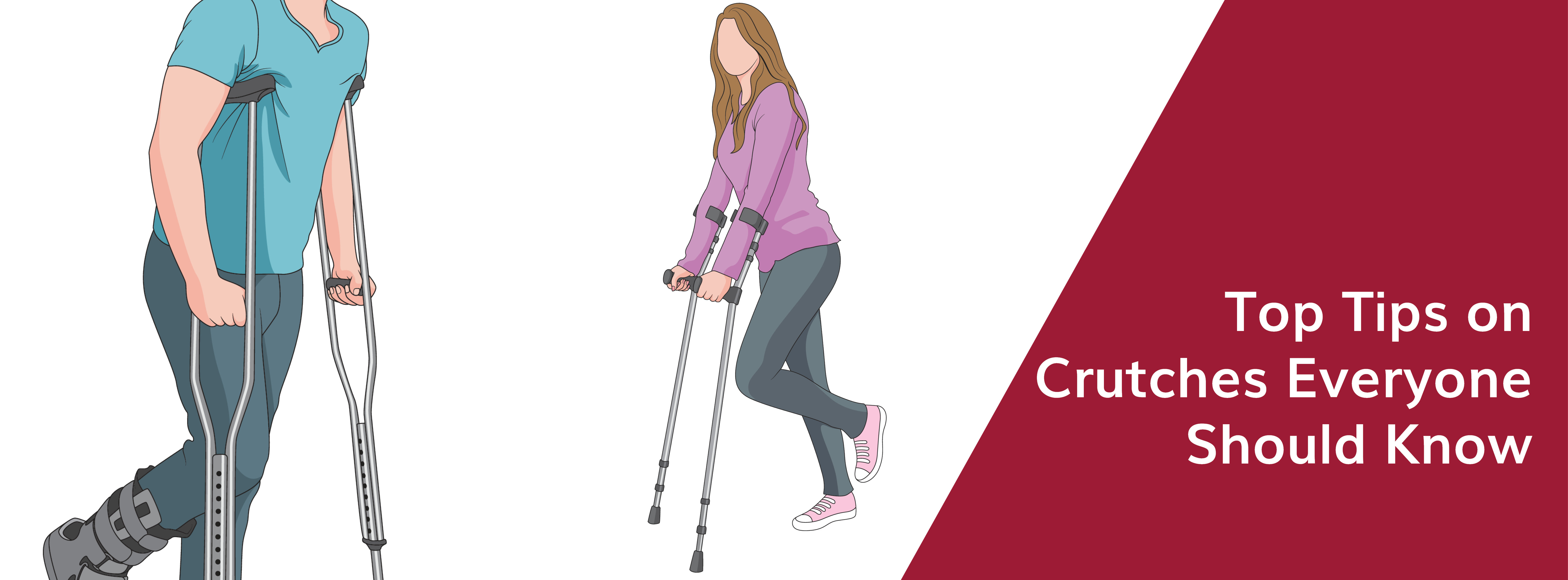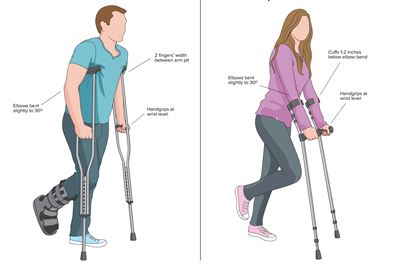At Access Rehabilitation Equipment, we commit to providing you and your loved ones solutions for life! Fitting your lifestyle, each aid and equipment is tailored to the unique challenges you are facing, so work with us to find the independence and mobility you want!

Crutches: Underarm or Forearm, what is the right choice for me?
For someone trying to choose just the right crutches, weighing all possible pros and cons is important. It’s not just something that can be decided upon on a whim or a coin toss. The most basic thing to cover is to find out more about the two different types of crutches: the underarm crutches and the elbow crutches (also referred to as forearm crutches).
The next step, ‘how can I walk with crutches’ is often what most people have difficulty with. Don’t feel embarrassed if you find this a challenge, there are techniques you can use to help you become both proficient and stable when walking with crutches!
What are the differences between underarm or forearm crutches?
Underarm (axilla) crutches are more often used for short term injuries, and are commonly recommended for users who can only bear weight with one leg. Lightweight and durable, these crutches are mostly made of aluminum designed with height adjustable handgrips and legs.
In comparison, elbow or forearm crutches are recommended for long-term use for those who can weight bear with both legs but simply require additional support with their mobility.
How do I pick which crutches to use?
When choosing the right crutches, there are several factors to consider to ensure they suit your needs and provide the necessary support. Here’s a quick guide to help you pick the most suitable crutches to use:
-
Consider which type of crutch suits your specific needs and comfort.
- Underarm crutches: These are the most common type and fit under your arms, with padded tops to support your weight. They are suitable for those with temporary injuries or conditions affecting their lower limbs.
- Forearm crutches: These have cuffs that wrap around your forearms and a handle to grip. They offer more stability and are often used by individuals with long-term mobility challenges.
- Hands-Free crutches: Depending on your injury or mobility level, you might explore hands-free crutches or knee scooters, which provide relief to your arms and shoulders.
- Gutter crutches: These crutches are mainly designed for arthritis patients or patients with impaired grip. The handgrip is adjustable and the handle rotates through 360 degrees. They are similar to traditional forearm crutches but have a unique design that offers additional forearm support.
-
It’s important to choose crutches that are the right size for your height and weight.
- Ensure the crutches are adjustable to your height. Your hands should rest comfortably on the handles with a slight bend in your elbows.
- Check the weight capacity of the crutches to ensure they can support your body weight. Most crutches have a weight capacity of 110-136 kgs.
-
Look for crutches that have comfortable hand grips and padding under the armpits.
- Try out the crutches to ensure they are comfortable and fit you well.
- Consider the padding and grip of the handles, as well as the design of the cuffs or underarm pads.
-
Consider the material.
- Aluminum crutches are the most common and are lightweight and durable.
- Wooden crutches may be less expensive but heavier and less durable.
- Carbon fiber crutches are the lightest and most expensive.
-
Consult with a healthcare professional.
-
It’s always best to consult with a healthcare professional such as a doctor, physical therapist or occupational therapist before selecting crutches. They can help determine what type of crutches are best suited for your condition and your specific needs.
How to set the right height for crutches:
Underarm Crutches:
- Stand tall with your shoes on.
- Put the crutches under your arms. Relax your arms and let them hang down over the crutches. There should be 1-1 ½ inch (or approximately 2 fingers’ width) space between your armpit and the top of the crutch with your hands hanging relaxed.
- The hand grips should be at the level of your wrist when holding the hand grips.
- Your elbows should be bent slightly to about thirty degrees.
Forearm Crutches:
- Stand tall with your shoes on. Relax your shoulders with your arms hanging loosely at your sides.
- The height of the handgrips should be at the crease of your wrist when holding the hand grips.
- To adjust the height, depress the spring button so the leg to lengthen or shorten to achieve the desired height.
- Once the height is properly adjusted, your elbow should be bend slightly to about 30ᴼ
Adjusting the cuff
- The cuff should be 1-2 inches below the bend of the elbow
- To adjust the height, depress the spring button on each cuff to lengthen or shorten to achieve the proper sizing
How do I use crutches?
HOW TO STAND UP WITH CRUTCHES
To stand up, take your crutches in one hand by holding the hand grips. Push down with your other hand on the chair.
Once up, arrange your crutches on each side of your body.
HOW TO SIT DOWN WITH CRUTCHES
To sit down, hold both crutches in one hand by holding the hand grips together and reach for the chair with your other hand and lower yourself into the chair slowly.
HOW TO WALK WITH CRUTCHES – WITH SOME WEIGHT BEARING
- To take a step, squeeze the crutches between your upper arms and ribs put the weight through your hands not your armpits.
- Move the crutches forward. Move your injured leg forward and put your foot even with the crutches. Put as much weight as you are allowed on the injured leg, taking the rest of the weight through your arms and hands.
- Step past with your stronger leg.
In summary, move the crutches first, your injured leg next, and then your stronger leg.
HOW TO WALK WITH CRUTCHES – WITH NO WEIGHT BEARING
- Place your crutches in front of you and sway forward with your hips.
- Swing your good leg forward between the crutches, stepping down next to your crutches.
HOW TO WALK WITH ONE CRUTCH
One crutch may be useful for walking when you have a slight problem with balance, some muscle weakness, injury, or pain in one leg.
- Hold the crutch in hand on the side opposite to the injured leg.
- Step forward with the injured leg moving the crutch forward with it at the same time. Put weight through the crutch when you step on the injured leg. Remember: the crutch should move forward with the injured leg at the same time.
- Step through with the uninjured/strong leg while putting weight through the crutch.
How can I walk on crutches without getting tired?
Using crutches can be extremely tiring, especially if you are new to walking with crutches. To minimize tiredness, it’s essential to:
- Ensure your crutches are properly adjusted to your height. The handles should be at wrist level when you stand up straight, and the crutch pads should fit comfortably under your armpits.
- Use your arms and upper body to support your weight on the crutches rather than relying solely on your armpits. Push down on the crutches’ handles as you lift your body with each step.
- Work on strengthening your upper body with exercises to build endurance.
- Take breaks and rest when needed
- Gradually increase your crutch-walking duration and distance as your strength improves.
- Consider using mobility aids or methods, like a knee scooter, if they are suitable for your condition.
How to walk without crutches?
As you improve and your injury heals, there will come a time when you need to progress off of the crutches and back to walking without them.
Walking without crutches after using them for an extended period or following an injury can be a gradual process. It’s crucial to take it step by step and prioritise safety and comfort.
- Consult a healthcare professional before starting to walk without crutches. They will assess your progress and ensure that it is safe for you to transition to walking without assistance.
- Begin by talking a few steps without crutches while holding onto a stable surface, like a countertop or handrail, for support. This allows you to gauge your balance and confidence in walking without crutches,
- As you feel more comfortable, increase the number of steps you take without crutches. Continue using a stable surface for support if needed.
- Gradually shift your body weight from your arms (on crutches) to your legs as you gain strength and stability. Focus on putting more weight on your stronger leg while keeping the other foot lightly touching the ground.
- Lean on walls, railings, or furniture for support, especially during the initial stages of walking without crutches.
- Consider using a cane or walking stick for additional support during the transition period.
- Be cautious about walking on uneven or slippery surfaces until you regain your full strength and balance.
Frequently Asked Questions
When using a crutch which leg goes first?
The injured leg always steps through first before the uninjured/strong leg. The sequence is: crutches forward, injured leg forward, then step through with the uninjured leg.
Is it better to walk with one crutch or two?
The choice between walking with one crutch or two depends on your specific injury, mobility level, and the guidance of your healthcare provider. Walking with one crutch can be beneficial for minor injuries or when you need minimal support. Otherwise, walking with two crutches may be preferred for more significant injuries, post-surgery recovery, or when you need more assistance with your balance.
What side do you use a single crutch on?
When using a single crutch, it typically goes on the opposite side of the injured leg. This means, if your right leg is weaker, you would use the crutch on your left side, and vice versa. This gives you better support and helps you walk with more normal movements. However, it’s required to follow the guidance of your healthcare provider or physical therapist, as they can provide specific instructions tailored to your condition and ensure proper technique while using crutches.
Do you use a crutch on a bad leg or good leg?
It is recommended to use a crutch under the arm on the side of your good/healthy leg – or in other words, on the opposite side of your bad/injured leg. This provides additional support and stability for the affected leg while walking.
When can I walk with one crutch?
The appropriate time to switch to using one crutch depends on your individual recovery process, strength, balance, and the advice of your healthcare provider. You may consider using one crutch when these conditions are met:
- You can bear some weight on your injured leg without significant pain or discomfort.
- Your balance has improved while using two crutches
- Your leg muscles have regained enough strength and flexibility to support weight while using one crutch
- You have developed a proper walking pattern and gait while using two crutches, which sould be carried over when using one crutch.
- Pain and discomfort are manageable, and your healthcare provider agrees that you are ready to progress to one crutch.
For more information on the use of crutches, view BJC HealthCare's video HERE.
The information in this article is not a substitute for professional care, and must not be used for self-diagnosis or treatment. Access Rehab Equipment assumes no liability for the information contained or for its use.



 Providing solutions for life
Providing solutions for life







